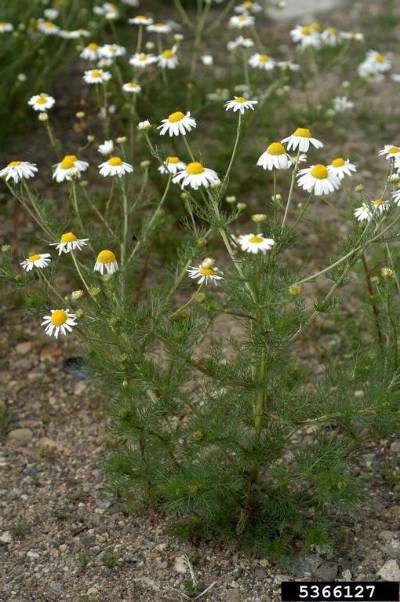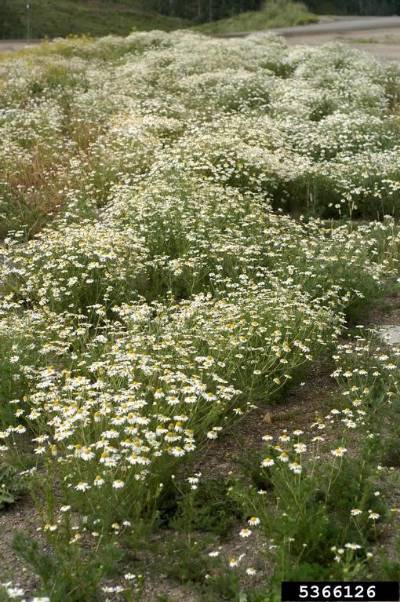Scentless chamomile (Tripleurospermum inodorum)

K. George Beck and James Sebastian, Colorado State University. www.bugwood.org
Download weed post on Scentless chamomile as PDF (includes word puzzle)
Introduction
Scentless chamomile is a short-lived forb that is native to Europe. It is known by several different names including scentless false mayweed and the Latin names Matricaria maritima and T. perforatum. Since its introduction to North America in the 1930’s, it has become widely distributed in North America from the southern United States to Alaska. This species is listed as a noxious weed in Colorado, New Mexico, and Washington as well as the Canadian province of British Colombia.
Identification and biology
Scentless chamomile displays a range of life histories- it can be an annual, biennial, or occasionally a short-lived perennial. It reproduces only by seed. Flowers are about 1 inch wide with white rays surrounding yellow discs, and leaves are highly divided and fern-like (photo, above right). This plant may be confused with others that are closely related such as oxeye daisy (Leucanthemum vulgare), a noxious weed in many western states. In contrast to scentless chamomile, oxeye daisy has larger flowers that are up to 2 inches wide, non-dissected leaves, and a rhizomatous growth habit. Another look-a-like is pineapple weed (Matricaria matricarioides). The leaves of

K. George Beck and James Sebastian, Colorado State University. www.bugwood.org
pineapple weed have a sweet pineapple-like odor when crushed, while scentless chamomile does not have a strong odor. Pineapple weed is also lacking white rays on flowering heads, and it tends to be a shorter statured plant compared to scentless chamomile.
Habitat and spread
Scentless chamomile grows in disturbed areas such as roadsides and fields. It is not considered competitive in healthy perennial plant communities. Seeds can be spread by human movement along roads and other transportation corridors, as well as in crop seed and animal feed.
Impacts
Scentless chamomile may cause blistering on muzzles of livestock, though most livestock will avoid the plant. The plant can also form dense stands along roadsides and in other disturbed locations (photo, below right).
Management options
Maintaining or establishing a healthy perennial plant community and avoiding bare ground is a good strategy for those interested in preventing the establishment and spread of this species as well as other species that are dependent on disturbance. Hand-pulling can be useful for small patches. Mowing before seed set may help reduce seed production, though scentless chamomile may re-flower below mowing height. Broadleaf herbicides such as aminopyralid and clopyralid are reported to be effective in controlling this plant. See the link under additional resources for more information.
